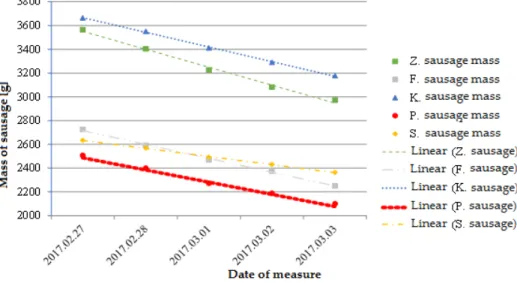Journal of Sustainable Development of Energy, Water and Environment Systems
http://www.sdewes.org/jsdewes Year 2019, Volume 7, Issue 4, pp 631-640
631
Journal of Sustainable Development of Energy, Water and Environment Systems
http://www.sdewes.org/jsdewes
Newly Developed Direct Current Refrigeration Technique to Improve the Sustainability of Sausage Drying Process
Miklos Kassai
Department of Building Services and Process Engineering, Budapest University of Technology and Economics, Muegyetem Rakpart 3-9, Budapest, Hungary
e-mail: kas.miklos@gmail.com
Cite as: Kassai, M., Newly Developed Direct Current Refrigeration Technique to Improve the Sustainability of Sausage Drying Process, J. sustain. dev. energy water environ. syst., 7(4), pp 631-640, 2019,
DOI: https://doi.org/10.13044/j.sdewes.d7.0278
ABSTRACT
The investment into sausage drying technology based on traditional technics using large-scale air handling unit, air ducts, boiler and traditional refrigerator is over the budget of the national agriculturist. The technological development has enabled the meat drying technology also for low budget enterprises nowadays. The object of this research was to investigate the sausage drying process in a small-scale test chamber with a novel direct current inverter condensing unit including the significant elements such as scroll compressor, electronic expansion valve and proportional-integral-derivative controller system. To achieve this object, the test facility was installed in the introduction room of Kassai-Klima Limited-Liability Company in which the drying process of 200 kg fresh sausages was investigated by experiments. During the tests, the electricity consumption of the condensing units was also measured. The total electrical consumption of the system was 5,160 kWh based on the electricity meter during the five days of experiment.
This way the energy efficiency and emissions could be monitored and compared with traditional sausage drying technologies.
KEYWORDS
Sausage drying, Experiment, Commercial refrigeration, Cold store, Variable speed direct current compressor, Energy consumption, Sustainability.
INTRODUCTION
Cutting and processing of pork for their meat is one of the most well-known traditions of Hungary. Sausage belongs to this kind, its process and consumption are traditionally typical in that country. Many different tastes of sausage can be defined, but there are elemental requirements for the end-product quality. These kinds of requirements include for example the appropriate smoking and drying. Smoking is required primarily for preservation, secondly for flavour. Drying makes the quality of sausage better [1]. It is one of the essential steps for producing the best sausage [2]. In the traditional way it is a very long procedure, and could last for several months with an adequate air condition and humidity [3]. Too fast (hours) or too slow (semi-annual) moisture reduction produces low quality products [4]. In former case the sausage crusts, i.e., its exterior is dry, but its inside stays too wet, in latter case there is a risk of moulding [5]. Among today’s economic conditions [6, 7] in the mass-production the half-year long drying is too long,
and must to be shortened [8]. The stress on the environmental quality is further imposed based on the demand for land area to support the current levels of food and material consumption in society [9]. The largest meat-trade companies (in case of processing sausage over one million tons simultaneously) use sausage-dryer chambers, where they secure adequate air conditions with air handling units. In traditional systems in general, it happens with blown-in dry warm air transported by air duct from air handling unit [10], which is installed close to the chamber [11, 12]. This warm dry air absorbs the moisture from the surface of the sausage [13], the moisture being transported by influence of partial pressure difference of water vapour, then this air is exhausted by diffusers via air duct into the handling unit [14]. The air flows across an air-cooler, its temperature is reduced, and a part of its moisture is condensed, so its absolute content of humidity decreases, then it is circulated through an air heater and dry, warm air is now again produced and can be recirculated in the room. In general, the air heater is a water-filled heat exchanger, to which a gas boiler (as a heat producing equipment) supplies the heating energy, the cooling demand for air-cooling is secured by a water-filled heat exchanger or by a direct evaporative cooling device [15]. However, these kinds of drying systems have a high cost of investment and energy demand. Although the latter factor is admitted for the meat-trade professionals, accurate consumption data could not be found during the research, because it is frequent in factories that other energy consumers (e.g., lighting, comfort heating, cooling, other technological devices, etc.) also work, so the costs of drying cannot be measured in a direct way. Large-scale factories also use chemical drying with silica gel. Then the air is contaminated with silicon-dioxide.
The advantage of chemical drying is its smallest energy demand among air conditioning methods. The positive attribution of this is that although the supposed surface is small (it is shaped as spheres), because of its porous texture its specific surface is enormous.
The gel is placed in towers, there are two towers: while one tower is regenerating with hot air, the other attends to the adsorption function. In Hungary, it is used in PICK Szeged Salami and Meat Factory Corp. (PICK Szeged Salami-producer and Meat processing plant ZRt.). Whichever drying-ageing method is used, it is important to go with planned, adequate parameters. However, smaller companies and primary producers – where the destination would be processing many hundreds of sausages at the same time – cannot afford the high investment and energy costs. With the evolution of technologies it would be possible to make such drying devices that enable to produce products by fast and by low energy consumption.
The object of this research was to investigate the drying characteristics and performance of sausages drying in an experimental cooling chamber, which operates with newly developed Proportional-Integral-Derivative (PID) controlled [16, 17] Direct Current (DC) inverter condensing units [18, 19]. To achieve this, an experimental test facility has been built in the introduction room of Kassai-Klíma Ltd., in which the drying of 200 kg sausages was investigated. The novelty of this research is quantifying of drying performance and its energy consumption given by experimental test using a novel developed small sized sausage drying technology that has affordable price also for the primary producers, and in addition the energy efficiency is increased and emissions is decreased of the sausage drying process compared with traditional sausage drying technologies.
MATERIALS AND METHODS
During the development of the test facility firstly the chamber was built.
Structure of the chamber
The chamber was built by Gabler-Mirelta Hungarian Ltd. Properties of the wall structure of the chamber are summarized in Table 1, given by the producer.
Table 1. Properties of the wall of the chamber
Size [mm] Type and thickness
of wall [mm] Type of insulation Overall heat transfer coefficient [Wm−2K−1] 1,660 × 1,660 × 2,330 NZ70 ‒ 70 Polyurethane foam 0.27
It must also be noted with respect to the cooling chamber, that it has a separate floor, which means that it is thermally insulated towards the ground. According to the developing company, the applied solution eliminates the heat bridge effect, so there is no point within the chamber, where heat can escape easily (Figure 1).
Figure 1. Position of the test chamber in the introduction room
In the present case, there is value difference between the inside air temperature (0 °C) of the chamber, and a constant 23 °C indoor air temperature around the chamber in the laboratory room.
Structure of the cold store
Two direct evaporators – connected to each other independent of the operating outdoor unit – were installed in the chamber (Figure 2).
Figure 2. Schematic diagram of the test facility
From the heat exchangers one is responsible for the cooling (as evaporator), the other secures the heating (as condenser) (Figure 3 and Figure 4).
Figure 3. The indoor cooling-heating unit in frontal view
Figure 4. The tubes of heat exchangers in the indoor unit (the cooler on the left side, the heater exchanger on the right side)
The exchangers operate together, so it is possible to keep along with the temperature, the relative and absolute humidity also in the required interval. The development of the indoor unit was due to the collaboration with the heat exchanger produced Inter-Thermo Ltd. (Table 2).
Table 2. The specifications of the indoor units
Type Cooling capacity [W] Refrigerant Air volume flow rate [m3/h] Power input [W]
IT-SZ Erl. 31-1-054 B4 5,410 R410A 1,300 85/38
The producer of the outdoor units – which can be used as a cooling equipment (to secure cooling efficiency) as well as heat pump (to secure heating efficiency) – and the PID controller were the Sinclair. The type of the outdoor units was Sinclair ASGE-09AIN WK, both heating and cooling units (Figure 5).
Figure 5. The outdoor units (on the top is the heater, at the bottom is the cooler)
The major parameters of the outdoor units based on the producer catalogue can be read in Table 3.
Table 3. The specifications of the outdoor units
Cooling Heating
Efficiency [kW] 2.7 (0.8-3.5) 2.9 (0.8-3.8)
Intake of efficiency [W] 840 800
Service intake of power [A] 3.9 3.7
Seasonal efficiency coefficient 6.1 (SEER) 3.8 (SCOP)
Energy class A++ A
Refrigerant R410A
Type of compressor Scroll
Electrical intake off efficiency 230 V/50 Hz
Type of doser Electronic doser valve
Air flow [m3/h] 1,800
Machine measure [mm] 850 × 540 × 320
Machine mass [kg] 34
Service interval of temperature [°C] −15-48 −15-24
Description of the control systems
The Sinclair SCMI-01 type PID controller of the DC inverter refrigerator (Figure 6) is more complicated. Besides the possibility of setting the inside air temperature of the chamber the constants relevant to the PID controller can also be set. Furthermore, it displays the actual speed of rotation (in percentage value) of the compressor, the temperature of the evaporator and the chamber, as well as the position of the expansion valve. The controller varies the rotation speed of the compressor and the position of electronic expansion valve (varying the cooling capacity, meeting the cooling demand) measuring the indoor air parameters of the chamber and comparing this value with the maintaining air parameters set on the controller continuously.
Figure 6. PID control unit of the DC inverter refrigerator
The settings of this measure according to the advice by the constructor are shown in Table 4.
Table 4. The settings of the cooling chamber
Maintaining indoor air temperature [°C]
Maintaining indoor relative humidity [%]
Fluctuation of indoor air temperature [°C]
Fluctuation of indoor air humidity [%]
14 70 ± 2 ± 5
The working cycle is the following: when the air parameters reach the upper limit of the set, the outdoor unit of the evaporator switches on and starts to cool the air of the chamber till the air parameters fall to the upper limit of the settings, when the outdoor unit of the condenser starts to operate. The specifications of electricity meter were used to monitor the energy consumption of both refrigeration systems which can be read in Table 5.
Table 5. Specifications of electricity meter
Type of the electricity meter Single-phase static electricity meter
Reference voltage/frequency 230 V/50 Hz
Meter constant [imp kWh−1] 1,000
Impulse constant output SO [imp kWh−1] 1,000
Rated voltage/frequency 230 V/50 Hz
Current range [A] 5
Precision class 1
Measurement of the material moisture content of sausages
The measurement of material moisture content of sausages was conducted with mass and moisture measure meter. EasyInox scale fabricated was used by Taurus Company, the maximum loadability of scale was 5 kg. For the latter measure a TK100 multifunctional universal material moisture measurer (Figure 7) was used. Although by the claims of the constructor it is able to measure the required value, however, in practice constant values of moisture were measured even though the remarkable mass reduction, this instrument could not be used for evaluation.
Figure 7. The material moisture measurer used at the experiment
THE DESCRIPTION OF THE EXPERIMENTAL TEST
For the investigation 200 kg of fresh-made sausage were used (Figure 8). During the test the indoor air temperature and the relative humidity were noted (between 7 AM and 4 PM) in every 30 minutes in a day, which were readable from the measure-display at the outdoor surface of the chamber. The energy consumption was recorded once a day.
The mass and material humidity of five sausages were also measured daily, which were marked before. During the preparation of the experimental investigation firstly the indoor air temperature and relative humidity required to be maintained were set, and then the initial values of the consumption measurer were read.
Figure 8. The sausages and their stand in the chamber
After the arrival of the test product, five sausages were chosen from different places of their stilling, these sausage-bunches were marked with different-colours (Figure 9).
Figure 9. The position of the marked sausage-bunches in the chamber [20]
The mass-loss of these sausage-bunches were noted before they were put into the chamber by using Steinberg precision weighing machine with +/−1 g accuracy.
The measure lasted from 27th February 2017 at 9 AM to 3rd March 2017 at 9 AM.
One bunch contained 4-5 sausages, their mass were a little bit different from each other.
At the end of the measure, the representative of the meat-company checked the state of the sausages, after his evaluation the products were in complete marketable condition, the required humidity drop was achieved, and further drying would cause quality deterioration.
RESULTS AND DISCUSSION
In Table 6 can be read the experimental result performed in daily period.
Table 6. Results of the experimental tests
τ mk,z φk,z mk,f φk,f mk,k φk,k mk,p φk,p mk,s φk,s E 02. 27. 3,564 84 2,725 84 3,664 84 2,507 84 2,634 84 19,095 02. 28. 3,404 83 2,591 83 3,551 83 2,400 83 2,569 83 21,049 03. 01. 3,225 82 2,469 82 3,411 82 2,272 82 2,490 82 22,508 03. 02. 3,082 81 2,376 81 3,291 81 2,188 81 2,431 81 23,084 03. 03. 2,971 80 2,250 80 3,177 80 2,100 80 2,364 80 24,255
The symbols in the Table 7 can be read as: τ is time of the measure [day], m is mass of sausage [g], φ is material moisture of sausage [%] and E is electrical consumption displayed by electricity meter [kWh].
The indexing means the colour of the marking bands: z ‒ green, f ‒ white, k ‒ blue, p ‒ red and s ‒ yellow.
On Figure 10, it can be seen that the mass reduction of sausages was nearly linear, which is confirmed by the adapted trendline and also its parameters.
Table 7. Mass reduction of sausages
Sign of sausage Green White Blue Red Yellow
Mass reduction [g] 593 475 487 407 270
Specific mass reduction [%] 16.63 17.43 13.29 16.23 10.25
Figure 10. The mass reduction of the sausages illustrated on diagram
From measured data, the mass reduction and specific mass reduction of the sausages could be also calculated (Table 7).
CONCLUSIONS
As a conclusion, we can see from the results that the selected sausage-bunches had different mass reduction depending on their position in the chamber. In three cases the amount of the mass reduction was almost the same, but the mass reduction rate of the blue and especially the yellow marked sausages diverge significantly from the others (Table 7).
The reason for the mass reduction differences is some inhomogeneous air conditions in the chamber that was provided. For improvement it is suggested to keep larger distance between the sausage-bunches in order to provide more homogeneous air conditions between the sausages in the chamber. The total electrical consumption of the system was 5,160 kWh based on the electricity meter during the whole experiment. Based on the recent industrial energy cost (0.085 Ft/kWh) it can be easily calculated, that during this time there is EUR 437 energy cost. It is important to note, that the cost of industrial energy depends on many facts, but generally it is more advantageous than the residential power rate.
From the results it can be also seen, that the selected sausages had different mass reduction hanging by its position in chamber. The reduction seems to be linear hanging by time. The mass reduction was existed fully from the reduction of moisture, which precipitated at the surface of the evaporator. This moisture was led away into a bucket near the chamber. According to the representative of the investor meat-company more than 20% of moisture reduction causes quality destruction of the meat.
It can be seen from the measured consumption results, that with the mass reduction of sausage it needed ever less energy for drying process and also there is an exponential tendency between the mass reduction and the energy consumption. The sausages got ready into eating after five days according to the professional delegate of the meat-company, who was satisfied also with the quality of the product. The amount of energy, which was consumed during the aging, is acceptable, its cost debits neither the budget of smaller investors. The developed system improves the sustainability of the sausage drying process, since the energy efficiency could be increased and emissions could be decreased compared to the developed device with the traditional sausage drying technologies when recirculatedair is heated by fossil fuel fired gas boiler and cooled by chiller using water-to-air heat exchangers.
ACKNOWLEDGMENT
This research project was financially supported by the National Research, Development and Innovation Office from NRDI Fund [grant number: NKFIH PD_18 127907], the János Bolyai Research Scholarship of the Hungarian Academy of Sciences, and the ÚNKP-18-4 New National Excellence Program of the Ministry of Human Capacities, Budapest, Hungary.
NOMENCLATURE
E electrical energy consumption [kWh]
m mass of sausage [g]
Greek letters
ϕ material moisture of sausage [%]
τ time [day]
Subscripts
f white
k blue
p red
s yellow
z green
REFERENCES
1. Baksa, P., Cepak, F., Kovacic Lukman, R. and Ducman, V., An Evaluation of Marine Sediments in Terms of their Usability in the Brick Industry: Case Study Port of Koper, Journal of Sustainable Development of Energy, Water and Environment Systems, Vol. 6, No. 1, pp 78-88, 2018, https://doi.org/10.13044/j.sdewes.d5.0183
2. Poos, T., Szabo, V., Varju, E. and Sebesi, V., Determination of Drying Rate at Herbs Drying with Ambient Air, Proceedings of the 4th International Scientific Conference on Advances in Mechanical Engineering (ISCAME 2016), Debrecen, Hungary, October 13-15, pp 408-413, 2016.
3. Magdeldin, M., Kohl, T. and Jarvinen, M., Techno-economic Assessment of Integrated Hydrothermal Liquefaction and Combined Heat and Power Production from Lignocellulose Residues, Journal of Sustainable Development of Energy, Water and Environment Systems, Vol. 6, No. 1, pp 99-113, 2018,
https://doi.org/10.13044/j.sdewes.d5.0177
4. Karabegovic, A., Energy Efficiency Improvement and Optimal Management of CHP District Heating System ‒ Case City of Tuzla, Proceedings of 8th Dubrovnik Conference on Sustainable Development of Energy, Water and Environment Systems (SDEWES), Book Series: Chemical Engineering Transactions, Dubrovnik, Croatia, September 22-27, Vol. 42, pp 7-12, 2014.
5. Anvari, S., Saray, R. K. and Bahlouli, K., Conventional and Advanced Exergetic and Exergoeconomic Analyses Applied to a Tri-generation Cycle for Heat, Cold and Power
Production, Energy, Vol. 91, pp 925-939, 2015,
https://doi.org/10.1016/j.energy.2015.08.108
6. Kilkis, S., Application of the Sustainable Development of Energy, Water and Environment Systems Index to World Cities with a Normative Scenario for Rio de Janeiro, Journal of Sustainable Development of Energy, Water and Environment Systems, Vol. 6, No. 3, pp 559-608, 2018, https://doi.org/10.13044/j.sdewes.d6.0213
7. Gazda, W. and Kozioł, J., The Estimation of Energy Efficiency for Hybrid Refrigeration System, Applied Energy, Vol. 101, pp 49-57, 2013,
https://doi.org/10.1016/j.apenergy.2012.05.006
8. Nyers, J., A New Analytical Method for Defining the Pump’s Power Optimum of a Water-to-Water Heat Pump Heating System Using COP, Thermal Science, Vol. 21, pp 324-324, 2016, https://doi.org/10.2298/TSCI161110324N
9. Bedoić, R. and Filipan, V., Heating Performance Analysis of a Geothermal Heat Pump Working with Different Zeotropic and Azeotropic Mixtures, Journal of Sustainable Development of Energy, Water and Environment Systems, Vol. 6, No. 2, pp 240-253, 2018, https://doi.org/10.13044/j.sdewes.d5.0189
10.Nyers, J., Kajtar, L., Slavica, T. and Nyers, A., Investment-savings Method for Energy-economic Optimization of External Wall Thermal Insulation Thickness, Energy and Buildings, Vol. 86, pp 268-274, 2014,
https://doi.org/10.1016/j.enconman.2014.05.050
11.Shafiei, S. E., Rasmussen, H. and Stoustrup, J., Modeling Supermarket Refrigeration Systems for Demand-Side Management, Energies, Vol. 6, No. 2, pp 900-920, 2013,
https://doi.org/10.3390/en6020900
12.Ricciu, R., Galatioto, A., Besalduch, L. A., Desogus, G. and Di Pilla, L., Building Wall Heat Capacity Measurement Through Flux Sensors, Journal of Sustainable Development of Energy, Water and Environment Systems, Vol. 7, No. 1, pp 44-56, 2019,
https://doi.org/10.13044/j.sdewes.d6.0234
13.Belman, F. J. M., Ledesma, S., Gallegos, M. A. and Hernandez, D., Thermal Simulation of the Fresh Food Compartment in a Domestic Refrigerator, Energies, Vol. 10, No. 1, pp 1-14, 2017, https://doi.org/10.12968/sece.2017.4.14
14.Sivakumar, M. and Somasudaram, P., Thermodynamic Investigations of Zeotropic Mixture of R290, R23 and R14 on Three-Stage Auto Refrigerating Cascade System, Thermal Science, Vol. 20, No. 6, pp 2073-2086, 2016,
https://doi.org/10.2298/TSCI140103091S
15.Wang, D., Lu, L. and Zhang, W., Overall Energy Performance Assessment of a New Heat Blocking Coating, Journal of Sustainable Development of Energy, Water and Environment Systems, Vol. 7, No. 1, pp 1-12, 2019,
https://doi.org/10.13044/j.sdewes.d6.0224
16.Zhang, S. and Cheng, Y., Performance Improvement of an Ejector Cooling System with Thermal Pumping Effect (ECSTPE) by Doubling Evacuation Chambers in Parallel,
Applied Energy, Vol. 187, pp 675-688, 2017,
https://doi.org/10.1016/j.apenergy.2016.11.080
17.Nyers, J., Garbai, L. and Nyers, A., A Modified Mathematical Model of Heat Pump’s Condenser for Analytical Optimization, Energy, Vol. 80, pp 706-714, 2015,
https://doi.org/10.1016/j.energy.2014.12.028
18. Ekren, O., Sahin, S. and Isler, Y., Comparison of Different Controllers for Variable Speed Compressor and Electronic Expansion Valve, International Journal of Refrigeration, Vol. 33, No. 6, pp 1161-1168, 2010,
https://doi.org/10.1016/j.ijrefrig.2010.05.005
19.Aström, K. J. and Hägglund, T., PID Controllers: Theory, Design, and Tuning (2nd ed.), Instrument Society of America, Research Triangle Park, North Carolina, USA, 1995.
20. Orban, P., Investigation of Procedure for Sausage Drying, Proceedings of the Conference of Scientific Students’ Associations, Budapest University of Technology and Economics, Budapest, Hungary, 2017.
Paper submitted: 06.12.2018 Paper revised: 16.04.2019 Paper accepted: 18.04.2019
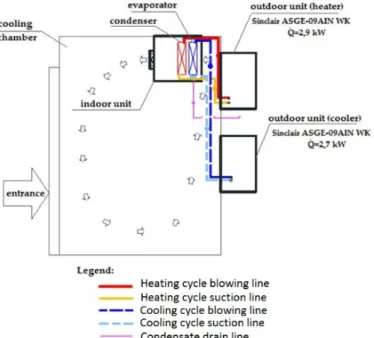
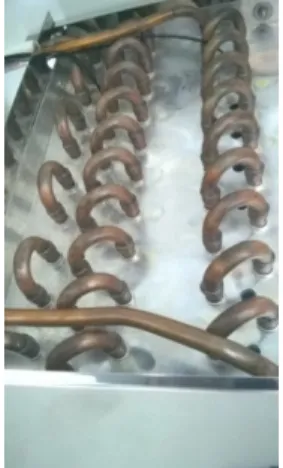
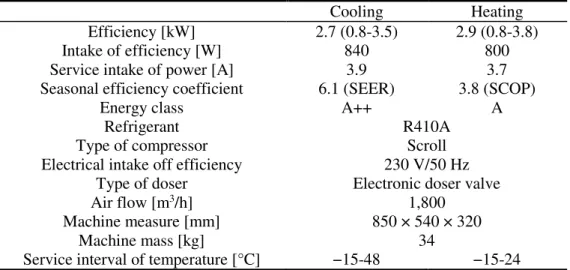
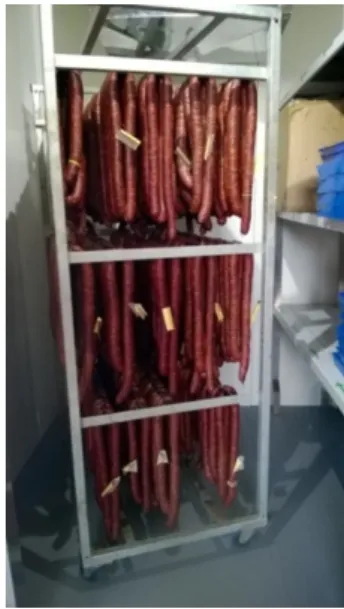
![Figure 9. The position of the marked sausage-bunches in the chamber [20]](https://thumb-eu.123doks.com/thumbv2/9dokorg/1323970.106775/7.892.330.601.137.413/figure-position-marked-sausage-bunches-chamber.webp)
